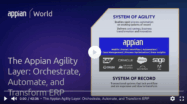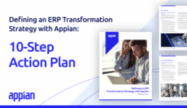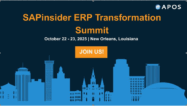Automotive
Filter By
Browse By
- SAP Analytics and AI
- SAP Application Development and Integration
- All SAP Application Development and Integration
- SAP ABAP
- SAP ABAP Development Tools
- SAP ABAP Test Cockpit
- SAP API Management
- SAP BAPI
- SAP Basis
- SAP BRF
- SAP Business Application Studio
- SAP CMS
- SAP Design Studio
- SAP Development Tools
- SAP DevOps
- SAP EAI
- SAP EDI
- SAP Extension Suite
- SAP Fiori
- SAP Fiori Elements
- SAP Integration Suite
- SAP Low Code Application Development
- SAP Low Code Automation
- SAP Netweaver
- SAP Release Management
- SAP UI5
- SAP Web Application Server
- SAP Web IDE
- SAP Business Process Management
- SAP Center of Excellence
- SAP CIO
- SAP Customer Experience
- SAP Data and Data Management
- All SAP Data and Data Management
- SAP BW
- SAP BW/4HANA
- SAP Crystal Reports
- SAP Data Archiving
- SAP Data Center
- SAP Data Governance
- SAP Data Integration
- SAP Data Migration
- SAP Data Quality
- SAP Data Services
- SAP Data Strategy
- SAP Data Visualization
- SAP Data Warehouse Cloud
- SAP DMS
- SAP Document Control
- SAP EIM
- SAP ETL
- SAP ETL Tools
- SAP HANA
- SAP HANA Administration
- SAP HANA Deployment Infrastructure
- SAP HANA Studio
- SAP Master Data
- SAP Master Data Governance
- SAP MDM
- SAP Enterprise Architect
- SAP Enterprise Asset Management
- SAP ERP
- SAP Finance
- All SAP Finance
- SAP Accounting
- SAP AR AP
- SAP Asset Accounting
- SAP Billing Systems
- SAP BPC
- SAP BRIM
- SAP Cash Management
- SAP Central Finance
- SAP Controlling
- SAP COPA
- SAP Cost Center Accounting
- SAP Currency Risk
- SAP e-invoicing
- SAP FICO
- SAP Finance Automation
- SAP Advanced Financial Closing
- SAP Financial Consolidation
- SAP Financial Planning
- SAP FX Risk
- SAP General Ledger
- SAP Global Tax Management
- SAP Hyperion
- SAP Order to Cash
- SAP Payment Processing
- SAP Profitability Analysis
- SAP Rebate Management
- SAP S/4HANA Finance
- SAP SWIFT Compliance
- SAP Treasury Management
- SAP Universal Journal
- SAP Governance Risk and Compliance
- SAP Human Capital Management
- SAP Intelligent Technologies
- SAP Platform and Technology
- All SAP Platform and Technology
- SAP Business Technology Platform
- SAP Cloud
- SAP Cloud Connector
- SAP Cloud Integration Platform
- SAP Cloud Migration
- SAP Cloud Platform
- SAP Cloud Providers
- SAP Cloud Strategy
- SAP Digital Signature
- SAP Container Platform
- SAP HANA Enterprise Cloud
- SAP Digital Asset Management
- SAP Smart Forms
- SAP HEC
- SAP Digital Integration Hub
- SAP Hyperscalers
- SAP Infrastructure
- SAP Messaging
- SAP Quality and Testing
- SAP Security
- SAP Spend Management
- SAP Supply Chain Management
- All SAP Supply Chain Management
- SAP APO
- SAP Asset Management
- SAP Business Network
- SAP Digital Manufacturing Cloud
- SAP Digital Twin
- SAP EWM
- SAP IBP
- SAP Inventory Management
- SAP Label Printing
- SAP Logistics
- SAP Manufacturing
- SAP Manufacturing Automation
- SAP MES
- SAP MII
- SAP MM
- SAP MRO
- SAP MRP
- SAP Order Management
- SAP Plant Maintenance
- SAP PLM
- SAP Production Planning
- SAP S&OP
- SAP SD
- SAP SPM
- SAP Supply Chain Planning
- SAP Track and Trace
- SAP Transportation Management
- SAP System Administration
SAP Automotive helps companies to drive profitable and sustainable new growth in the dynamic world of mobility. There is increasing pressure today for carmakers, suppliers, and dealerships to transform their businesses and prepare for a future of mobility. Five key areas include:
- Vehicle electrification
- Connected cars
- Mobility services
- Operational resilience
- Digitalized retailing
SAP Automotive helps companies to drive profitable and sustainable new growth in the dynamic world of mobility. There is increasing pressure today for carmakers, suppliers, and dealerships to transform their businesses and prepare for a future of mobility. Five key areas include:
- Vehicle electrification
- Connected cars
- Mobility services
- Operational resilience
- Digitalized retailing
The race for automotive digital transformation stems from:
- EV manufacturing and adoption. Climate change and innovative technologies are driving an increase in electric vehicles, suppliers are manufacturing more plugin, hybrid, electric vehicles, plugging stations and batteries.
- Connected cars and advanced driver assistance programs. Carmakers integrated more smart technology like LIDAR, ultrasound, and loT sensors through a cloud-based vehicle.
- Mobility as a service (MaaS) and shared mobility. Car sharing business models, such as Uber and Toyota’s Kinto program are meeting consumer demand with greater value, convenience, and sustainability.
- Resilient automotive supply chains. Increasing on board technology and EV components are adding greater complexity to supply chains, companies need real-time visibility for advanced analytics.
- Automotive digital retailing. With contactless car buying becoming preferred buying route, e-commerce technology and CRM data are used to support omni-channel vehicle sales.
- Drive to sustainability. Automakers are feeling the pressure to prioritize lower carbon footprints, so they need the ability to trace materials and components efficiently across the entire value chain.
Featured SAP Automotive solutions are:
- SAP E-Mobility
- Building, monitoring, and running EV charging networks at scale with a cloud solution offering end-to-end functionality from charging scenarios to electronic billing.
- SAP Returnable Packaging Management
- Ability to track returnable packaging materials like crates, boxes, and pallets in real-time to reduce waste and run a sustainable automotive supply chain.
- SAP Industry Network for Automotive
- Enable next generation processes by an open and intelligent industry network.
SAP software solutions for the automotive Industry include:
- Research development and engineering
- Manufacturing and outbound logistics
- Responsive supply networks
- Sales and marketing
- Aftermarket service
- Smart mobility and transformation
Key considerations for SAPinsiders are:
- Leveraging Technology to Address Automotive Industry Challenges. In this market insight read how automotive suppliers have a need for focused tools to help manage unique business processes. To get an expert perspective, we asked Sahil to identify some of the top challenges that he believes Tech Mahindra’s customers in the automotive supplier industry are grappling with.
- McLaren Races Ahead in the Cloud. This case study covers the auto racing industry and how it is defined by the data a company can generate and analyze. Discover how McLaren harnessed SAP HANA on SAP HANA Enterprise Cloud to get the information it needed to remain a champion.
53 results
-

Navigating M&A Compliance: Key Challenges and Solutions for Mergers, Acquisitions & Divestitures
Reading time: 4 mins
Mergers, acquisitions, and divestitures demand strategic management of IT systems and data to maintain compliance and operational stability. Companies face challenges such as integrating or separating complex infrastructures, managing data effectively, and retiring outdated systems. By adopting structured solutions, like improving data governance, optimizing business processes, and leveraging modern technologies, organizations can turn these transitions…
-

Introduction to Appian
Reading time: 1 min
Appian brings orchestration, automation, and intelligence together in a secure, performant platform for managing your most complex processes. Consolidate your enterprise systems with data fabric, simplify your application architecture with low-code design for building apps and workflows, and unleash your process potential with AI-powered automation for a more adaptable and optimized business. Move your business…
-

The Appian Agility Layer: Orchestrate, Automate, and Transform ERP
Reading time: 1 min
Modernizing ERP systems can take years without the right technology. See how Appian streamlines the process and reduces migration risks—unlocking value faster from SAP S/4HANA and other ERP systems.
-
-

Defining an ERP Transformation Strategy with Appian
Reading time: 1 mins
Modernizing ERP doesn’t have to mean disruption. With Appian, you can show value in weeks, keep your core clean, and reduce risk at every step.
-

Bridging the Gap: Migrating from SAP ECC to S/4HANA Cloud
Reading time: 1 min
Download the guide to migrating from ECC to S/4HANA Cloud to learn how you can unlock the benefits of SAP modernisation without disrupting operations.
-

Integrating Appian with SAP
Reading time: 1 min
Integrating Appian with SAP Organizations across industries and functions—supply chain management, finance, human resources, manufacturing, procurement, product development, and more—use SAP as their Enterprise Resource Planning solution (ERP). SAP addresses many business needs, but organizations often have to customize their SAP solution to conform to the company’s operations. Fortunately, with Appian, you can quickly deliver…
-

Key Success Factors for a Sustainable SAP ERP Cloud Migration
Reading time: 1 min
ICYMI: Kevin F. Reilly, ETS Customer Success Officer, highlighted essential factors for successfully migrating to SAP ERP Cloud during his presentation at the SAPinsider Transformation Summit.
-
-

Overcoming Supply Chain Blind Spots With SAP Core
Reading time: 3 mins
To enhance efficiency in today’s volatile supply chain, organizations must integrate real-time external data with their SAP systems, enabling collaboration with suppliers, optimizing logistics, ensuring unit-level traceability, and utilizing a centralized control tower for proactive decision-making.
-

📌 FREE WEBINAR: PL119-21 Summary Changes to SECURE 2.0 Q4 2025
Reading time: 1 min
Event: Wednesday, November 12th, 11:00 AM – 12:00 PM, ET
-

APOS at SAPinsider ERP Transformation Summit!
Reading time: 1 mins
APOS is looking forward to joining the SAP community in New Orleans at SAPinsider ERP Transformation Summit as a proud sponsor. Join us for a collaboration session on “Generating & Delivering Personalized Financial & Operational Reports on Multiple Platforms” in our booth at 10:05 Oct 22. Finance and operations teams modernizing their SAP Analytics and…
Become a Member
Unlimited access to thousands of resources for SAP-specific expertise that can only be found here.
Become a Partner
Access exclusive SAP insights, expert marketing strategies, and high-value services including research reports, webinars, and buyers' guides, all designed to boost your campaign ROI by up to 50% within the SAP ecosystem.
Upcoming Events
-

SAPinsider Technology Executive Forum
December 02 - 03, 2025
Phoenix, Arizona
United States
View Event
Related Vendors
Your request has been successfully sent

